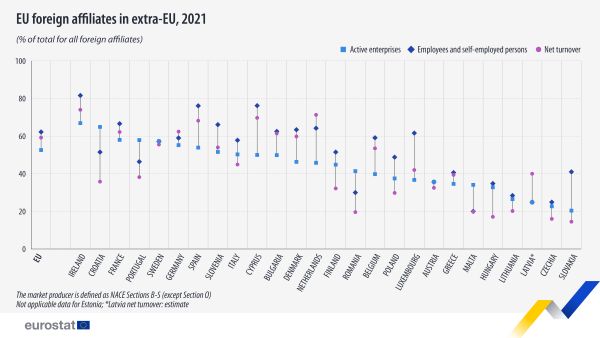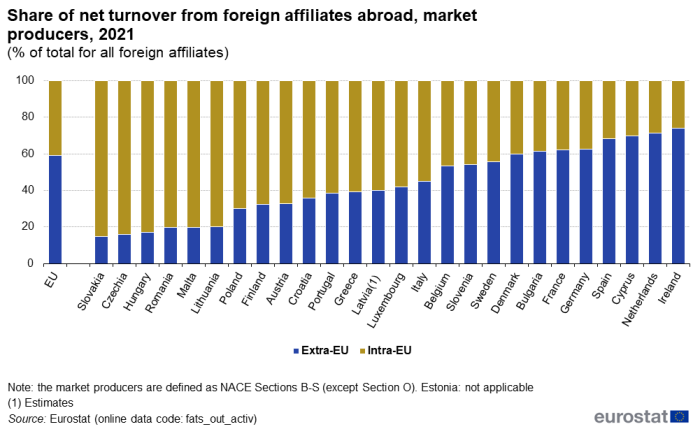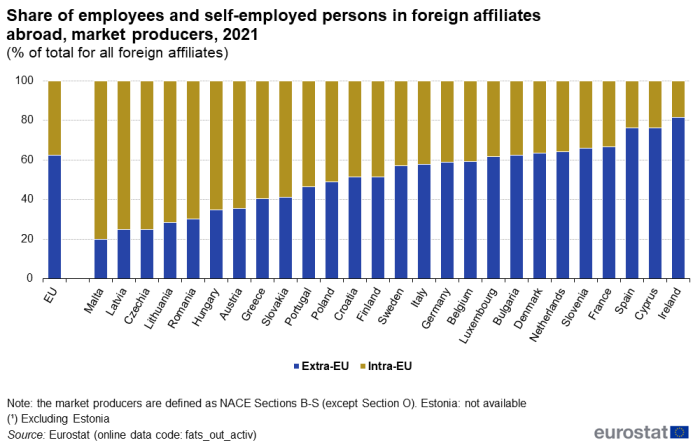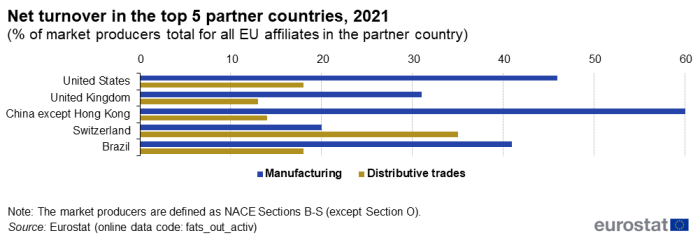Foreign-controlled enterprises statistics - outward FATS
Data extracted in April 2024.
Planned article update: December 2024.
Highlights
In 2021, the net turnover generated by EU affiliates located outside the EU was more than that of EU affiliates located in other EU countries.
Almost two out of every three employees and self-employed persons of an EU affiliates in 2021 were working outside the EU.
In 2021, manufacturing and distributive trades were the most significant areas of activity for EU affiliates abroad.

(% of total for all foreign affiliates)
Source: Eurostat (fats_out_activ)
This article looks at outward foreign affiliate statistics, providing information on the economic impact in EU affiliates abroad: for example, how many persons were employed by German affiliates in China, or what was the net turnover generated by French affiliates in the United States. Another article Foreign-controlled enterprises statistics - inward FATS looks at inward FATS. Note that the information presented in this article covers the market producers defined as NACE Sections B-S (excluding O).
Statistics on foreign affiliates
For statistical purposes, foreign affiliates are considered to be enterprises resident in one country and controlled by an institutional unit resident in another. There are two distinct sources of information: so-called inward FATS, which cover the activities of enterprises within the EU that are under foreign control and outward FATS, which cover the activities of EU affiliates abroad.
The globalised economy is increasingly characterised by intricate business networks. As a result, it can be difficult to untangle these complicated and often blurred chains of control. To do so, statistics on foreign affiliates are compiled according to the ultimate controlling institutional unit (UCI) — determined by proceeding up a foreign affiliate's chain of control until there is no further controlling interest; by doing so, potential double-counting of the same affiliates (by several countries) can be avoided. In this context, control refers to the ownership of a controlling share of the shareholders' voting power and the ability to determine the general policy of an enterprise, for example by choosing appropriate directors. In this way, an enterprise is said to be controlled by an institutional unit when the latter (a single investor or a group of investors acting together) owns — directly or indirectly — more than half of the voting shares in the enterprise.
Full article
Net turnover and employment by EU affiliates abroad
In 2021, the net turnover generated by EU affiliates located outside the EU were greater than those made by EU affiliates located in other EU countries
In 2021, a majority (59.2 %) of the net turnover made by EU affiliates abroad was generated outside the EU (in non-EU countries). The remaining 40.8 % reflected net turnover generated by EU affiliates in other EU countries. Note that these figures are based on an aggregate for 26 EU countries (excluding Estonia) and cover the market producers (as defined by NACE Sections B-S excluding O).
Irish (74.0 %), Dutch (71.3 %) and Cypriot (69.7 %) affiliates recorded the highest shares of their total net turnover generated outside the EU. By contrast, more than three-quarters of the net turnover that was generated by Slovakian, Czech, Hungarian, Romanian, Maltese and Lithuanian affiliates was made in other EU countries (see Figure 1).

(% of total for all foreign affiliates)
Source: Eurostat (fats_out_activ)
Six out of ten employees and self-employed persons by an EU affiliate in 2021 were working outside the EU
A similar analysis is presented in Figure 2 with a focus on those people who were working for EU affiliates outside the EU. In 2021, almost two-thirds (62.2 %) of the total number of employees and self-employed persons in the EU affiliates abroad were working outside the EU; note that these figures are based on information available for 26 EU countries (excluding Estonia) across the market producers. In 15 of these 26, a majority of the foreign affiliate workforce was found to be working outside the EU, with the highest proportions recorded among Irish (81.6 %), Cypriot (76.2 %), Spanish (76.1 %), French (66.6 %) and Slovenian (66.1 %) affiliates. In the other EU countries, at least a seventh of the workforce in their foreign affiliates abroad was employed in non-EU countries (see Figure 2).

(% of total for all foreign affiliates)
Source: Eurostat (fats_out_activ)
EU affiliates abroad in manufacturing and distributive trades
Manufacturing and distributive trades were the most significant areas of activity for EU affiliates abroad
In 2021, the United States was the most significant partner country in terms of both net turnover and employment generated by EU affiliates abroad. Manufacturing and distributive trades were the two largest areas of economic activity for EU affiliates abroad.
The top five partner countries in terms of net turnover by EU affiliates were: the United States, United Kingdom, China, Switzerland, and Brazil. The share of the net turnover in manufacturing and distributive trades in relation to the total net turnover of EU affiliates in each of these countries is shown in Figure 3.

(% of market producers total for all EU affiliates in the partner country)
Source: Eurostat (fats_out_activ)
Figure 4 shows a similar analysis for employment by EU affiliates abroad. The top five partner countries in terms of employment in EU affiliates were: the United States, India, China, United Kingdom and Brazil. The share of employment in manufacturing and distributive trades in relation to the total workforce of EU affiliates in each of these countries is shown in Figure 4. For example, in the United States, employment in manufacturing represented 34 % of total employment in the market producers generated by EU affiliates in the United States.

(% of market producers total for all EU affiliates in the partner country)
Source: Eurostat (fats_out_activ)
Source data for tables and graphs
Direct access to
- Globalisation in business statistics (gbs), see:
- Foreign controlling EU enterprises - outward FATS (fats_out)
European business statistics compilers' manual for Foreign affiliates statistics
Metadata
Further methodological information